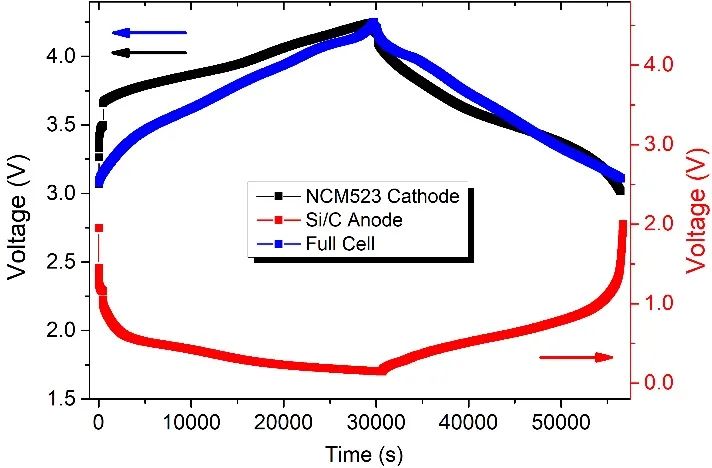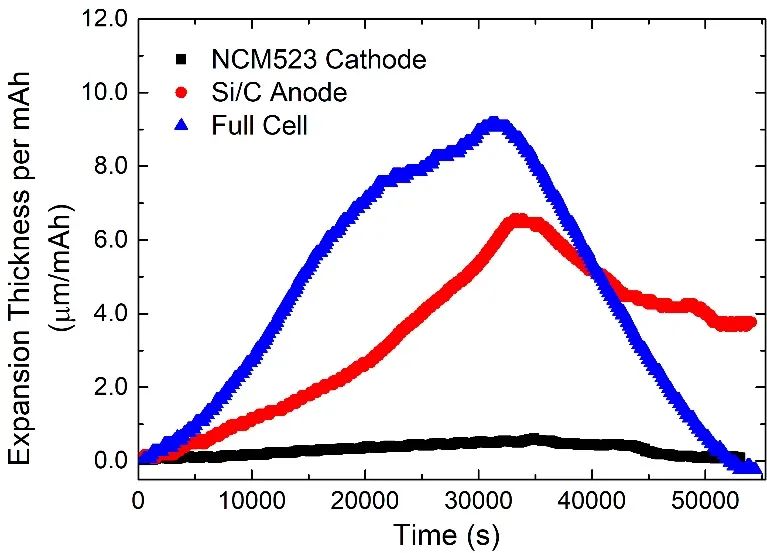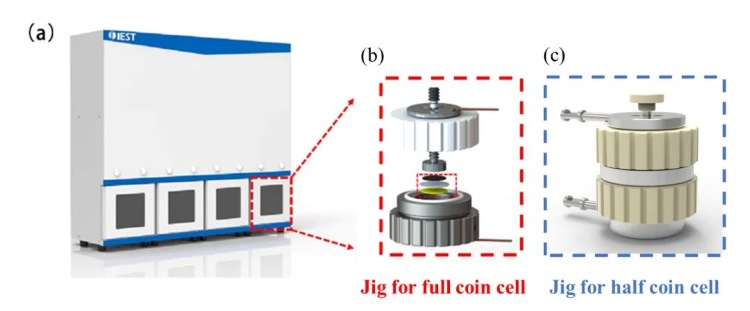Expansion and Decomposition Comparison of Positive and Negative Electrodes in Lithium-Ion Batteries
Lithium-ion batteries will undergo structural expansion or contraction due to the deintercalation of lithium during the charge and discharge process. When charging a lithium-ion battery, what happens on the negative electrode side is the process of lithium intercalation (such as graphite negative electrodes, hard carbon negative electrodes, etc.) or alloying lithium insertion (such as silicon-based negative electrodes, lithium metal negative electrodes, etc.) ,therefore, negative electrode materials generally undergo significant volume expansion as the depth of lithium embedding increases. For example, graphite negative electrodes generally produce a volume expansion of 10 to 15%, while silicon-based negative electrodes can produce a maximum volume expansion of 300%. However, for lithium battery cathode materials, what occurs during the charging process is a delithiation process, so will its structure shrink as the delithiation depth increases? The answer was "no". Literature research shows that NCM or LCO cathode materials will also undergo structural expansion during charging and delithiation. This is because the removal of lithium ions will increase the interlayer Coulomb repulsion in the c-axis direction of the microcrystalline structure of the cathode material, resulting in macroscopic Structural expansion[1,2].
Usually, people always use the whole battery as the main body to study the volume changes of the battery during the charge and discharge process. Although this method is simple to operate, the results can only reflect the overall expansion of the positive and negative electrodes, it is impossible to further decouple the expansion of the positive and negative electrodes, and comparatively analyze the contribution proportions of the positive and negative electrode materials to the overall expansion behavior of the full battery. Nor can it answer the above questions about the expansion behavior of the positive electrode materials.
So can we use a half-cell to decouple the expansion ratio of the positive and negative electrodes? Since lithium sheets will undergo great volume expansion during the process of deintercalation and deintercalation of lithium [3], the traditional half-cell assembly method is still unable to effectively decompose the expansion behavior of the positive and negative electrodes. Based on this, IEST adopts special structural design and processing technology to isolate the expansion interference of the lithium sheets in the half-cell, thereby effectively decoupling and analyzing the expansion of the positive and negative electrode sheets!
1.Testing Conditions
1.1 Testing Equipment
The in-situ charge and discharge expansion test of the positive and negative half-cells uses IEST's self-made monopole expansion test mold, while the expansion test of the button full battery uses IEST's self-made model buckle mold. The structural diagrams of the two are respectively As shown in Figure 1(c) and (b). The changes in the expansion thickness of the two in different lithium insertion states were recorded in real time through the silicon-based negative electrode expansion in-situ rapid screening system (RSS1400, IEST) equipped with a high-precision thickness sensor, as shown in Figure 1(a).
Figure 1.(a) Silicon-based anode expansion in-situ rapid sieving system (RSS1400, IEST) and test button full cell (b) button half cell (c) Corresponding mold for volume expansion
1.2 In-situ Testing Process
①The positive electrode is made of NCM523 material, and the negative electrode is made of SiC material. First, it is assembled into a button full battery in IEST's self-made model buckle (as shown in Figure 1(b)), and under the condition of 5kg preload force at a rate of 01C Charge and discharge, while recording the expansion curve of the button-type full battery in-situ.
②Then assemble the button half cells of NCM523 positive electrode and SiC negative electrode respectively in the monopole expansion test mold (shown in Figure 1(c)), and charge and discharge at a rate of 01C under the condition of 5kg preload force. At the same time, the thickness expansion curve of the positive or negative electrode piece was recorded in-situ.
2.Results Analysis
Table 1 shows the charge and discharge capacity and efficiency of button half cells and button full cells after two cycles. The efficiency of positive and negative half cells is slightly lower than that of commercial 2032 button cells, this is caused using a special fixture structure and a special ceramic diaphragm in the expansion mold of the monopolar piece. Since the charge and discharge capacity is positively related to the corresponding thickness expansion, and the capacity of the positive and negative half cells is inconsistent with that of the full battery, if you want to compare the expansion behaviors of the three, you need to normalize their capacity, that is, the thickness expansion produced by the unit charge and discharge capacity of the three is compared.
Figure 2 shows the charge and discharge curves of three batteries in the second cycle of charging. We normalized them according to their respective capacity performance, the charge and discharge range of the full cell (NCM523 // SiC) and the positive half cell (NCM523 // Li) is 3~4.25V, while the charge and discharge range of the negative half cell (SiC // Li) is 0.005~2V. Figure 3 shows the expansion thickness changes of the three batteries during the second charge and discharge cycle. It can be seen from this that the thickness expansion of the full battery during charging and discharging mainly comes from the negative electrode side, and accounts for more than 80%, the volume expansion on the cathode side only accounts for less than 10%, which is consistent with test results in other literature [4,5]. In addition, according to relevant data, the volume expansion of the current mainstream cathode materials is roughly [4,5]: LFP-6.5%, LCO-1.9%, LMO-7.3%, NCM-6.5% (depending on Ni content), NCA-6%.
Table 1. Comparison of charge and discharge capacity and efficiency between positive and negative electrode button half cells and button full cells after two cycles


Figure 2.Voltage changes with time in the second cycle of charge and discharge of positive and negative electrode button half cells and button full cells. To facilitate the comparison between the three, normalization was carried out according to the capacity utilization.

Figure 3.The change curve of the unit capacity expansion with time of the positive and negative electrode button half cells and button full cells in the second cycle of charge and discharge. To facilitate the comparison between the three, normalization was carried out according to the capacity utilization.
3.Summary
This article uses the monopole sheet expansion test mold developed by IEST to decompose and compare the expansion behavior of the positive and negative electrode sheets of lithium-ion batteries. Because this mold uses a special structural design and a special ceramic diaphragm, its charge and discharge efficiency will be slightly lower than that of commercial 2032 charge, however, it can still be seen from the expansion test results that the thickness expansion of the button-type full battery mainly comes from the negative electrode side, accounting for more than 80%, while the volume expansion of the positive electrode side accounts for less than 10%. this is consistent with the test results in other literature[4,5]. This result will help researchers to comparatively analyze the contribution of positive and negative electrode materials to the volume expansion of the full battery, to optimize and modify materials in a more targeted manner and accelerate the development of high-capacity, low-expansion materials!
4.Reference Materials
[1]F.B. Spingler, S. Kucher, R. Phillips, E. Moyassari and A. Jossen, Electrochemically Stable In-Situ Dilatometry of NCM, NCA and Graphite Electrodes for Lithium-ion Cells Compared to XRD Measurements. J. Electrochem. Soc. 168 (2021) 040515.
[2]B. Rieger, S. Schlueter, S.V. Erhard and A. Jossen, Strain Propagation in Lithium-ion Batteries from the Crystal Structure to the Electrode Level. J. Electrochem. Soc. 163 (2016) A1595-A1606.
[3]C. Luo, H. Hu, T. Zhang, S.J. Wen, R. Wang, Y.N. An, S.S. Chi, J. Wang, C.Y. Wang, J. Chang, Z.J. Zheng and Y.H. Deng, Roll-to-Roll Fabrication of Zero-Volume-Expansion Lithium-Composite Anodes to Realize High-Energy-Density Flexible and Stable Lithium-Metal Batteries. Adv. Mater. 34 (2022) 2205677.
[4]R. Koerver, W.B. Zhang, L. Biasi, S. Schweidler, A.O. Kondrakov, S. Kolling, T. Brezesinski, P. Hartmann, W.G. Zeier and J. Janek, Chemo-mechanical expansion of lithium electrode materials - on the route to mechanically optimized all-solid-state batteries. Energy Environ. Sci. 11 (2018) 2142-2158.
[5]Y. Koyama, T.E. Chin, U. Rhyner, R.K. Holman, S.R. Hall and Y.M. Chiang, Harnessing the Actuation Potential of Solid-State Intercalation Compounds. Adv. Funct. Mater. 16 (2006) 492-498.

